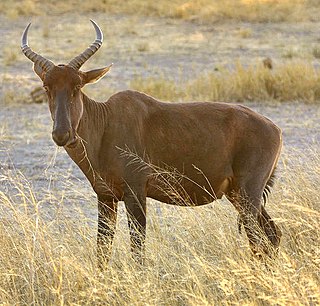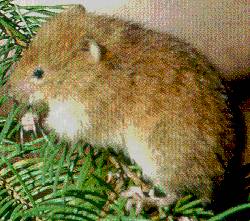
Voles are small rodents that are relatives of lemmings and hamsters, but with a stouter body; a longer, hairy tail; a slightly rounder head; smaller eyes and ears; and differently formed molars. They are sometimes known as meadow mice or field mice in North America.

The bovid subfamily Reduncinae or tribe Reduncini is composed of nine species of antelope, all of which dwell in marshes, floodplains, or other well-watered areas, including the waterbucks and reedbucks. These antelopes first appear in the fossil record 7.4 million years ago in Eurasia and 6.6 Mya in Africa.

The subfamily Alcelaphinae, of the family Bovidae, contains the wildebeest, tsessebe, topi, hartebeest, blesbok and bontebok, and several other related species. Depending on the classification, there are 6–10 species placed in four genera, although Beatragus is sometimes considered a subgenus of Damaliscus, while Sigmoceros is sometimes considered for the Lichtenstein's hartebeest.

The Arvicolinae are a subfamily of rodents that includes the voles, lemmings, and muskrats. They are most closely related to the other subfamilies in the Cricetidae. Some authorities place the subfamily Arvicolinae in the family Muridae along with all other members of the superfamily Muroidea. Some refer to the subfamily as the Microtinae or rank the taxon as a full family, the Arvicolidae.

Clethrionomys is a genus of small, slender voles. In recent years the genus name was changed to Myodes, however a 2019 paper found that Myodes was actually a junior synonym for Lemmus, thus making it unusable. As such, Clethrionomys is re-established as the proper genus name. At the same time, several species were moved to the genus Craseomys, so members of both genera are referred to as red-backed voles.

The genus Arborimus is a group of voles found in western North America. The genus name is Latin for "tree mouse". Some sources include this genus with the heather voles, genus Phenacomys, and both are classified in the tribe Phenacomyini.

The water voles are large voles in the genus Arvicola. They are found in both aquatic and dry habitat through Europe and much of northern Asia. A water vole found in Western North America was historically considered a member of this genus, but has been shown to be more closely related to members of the genus Microtus. Head and body lengths are 12–22 cm, tail lengths are 6.5–12.5 cm, and their weights are 70–250 g. The animals may exhibit indeterminate growth. They are thick-furred and have hairy fringes on their feet that improve their swimming ability.
The royal vole, also called the Korean red-backed vole, is a species of vole endemic to the Korean Peninsula. It lives underground in a burrow, emerging at night to feed on grasses, seeds and other vegetation. The International Union for Conservation of Nature has listed its conservation status as being of "least concern".

The grey red-backed vole or the grey-sided vole is a species of vole. An adult grey red-backed vole weighs 20-50 grams. This species ranges across northern Eurasia, including northern China, the northern Korean Peninsula, and the islands of Sakhalin and Hokkaidō. It is larger and longer-legged than the northern red-backed vole, which covers a similar range and it is also sympatric with the Norwegian lemming.

Alticola is a genus of rodent in the family Cricetidae.

The silver mountain vole is a species of rodent in the family Cricetidae. They are distinguished by their silver-grey pelage, long vibrissae, rootless hypsodont molars and angular skull shape. Like many mammals of the Eurasian Steppe eco-region, they are well adapted to life in high altitudes, and can be found in mountain areas of Central Asia from Saur Mountains in the north-east to Kugitang Range in the west, and to Tibet and the Himalayas in the south.
The central Kashmir vole is a species of rodent in the family Cricetidae. In addition to Kashmir, it is found in India and Pakistan.
The Hokkaido red-backed vole is a species of rodent in the family Cricetidae. It is found at high altitudes on the island of Hokkaido in Japan and at lower altitudes on some smaller islands nearby. Its natural habitat is temperate forests.

Ellobius is a genus of rodents in the family Cricetidae. It is the only member of the tribe Ellobiusini. It contains two of the handful of examples of mammal species that have lost the Y chromosome.
Craseomys is a genus of small, slender voles.

Microtini is a tribe of voles in the subfamily Arvicolinae.











